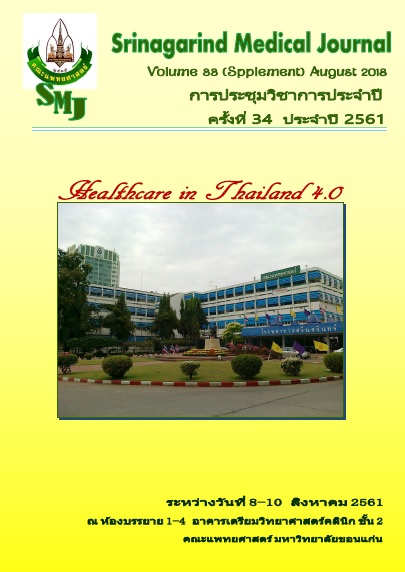การทบทวนรูปแบบและความเหมาะสมของขนาดยาต้านการแข็งตัวของเลือดชนิดรับประทานกลุ่มใหม่ในผู้ป่วยนอก ณ โรงพยาบาลศรีนครินทร์
คำสำคัญ:
New oral anticoagulants (NOACs); drugs utilization review; potential drug-drug interactionsบทคัดย่อ
หลักการและวัตถุประสงค์: ยาต้านการแข็งตัวของเลือดชนิดรับประทานกลุ่มใหม่ (new oral anticoagulants; NOACs) เป็นยาทางเลือกที่พบข้อดีหลายประการเหนือกว่า warfarin แต่มีข้อจำกัด และพบปัญหาการสั่งใช้ยาในขนาดยาที่ไม่เหมาะสม งานวิจัยนี้จึงมีวัตถุประสงค์เพื่อทบทวนรูปแบบการใช้และความเหมาะสมของขนาดยา NOACs ในผู้ป่วยนอกที่เข้ารับการรักษาที่โรงพยาบาลศรีนครินทร์ในช่วง 1 ปี หลังเริ่มใช้ยา
วิธีการศึกษา: เป็นการศึกษาเชิงพรรณนา โดยเก็บข้อมูลย้อนหลังจากฐานข้อมูลอิเล็กทรอนิกส์และเวชระเบียนของผู้ป่วยนอกที่เริ่มได้รับยาในช่วงเดือนธันวาคม พ.ศ. 2555–2559 ที่โรงพยาบาลศรีนครินทร์
ผลการศึกษา: พบการสั่งใช้ยากลุ่ม NOACs ในผู้ป่วย 103 ราย (475 ใบสั่งยา) ในข้อบ่งใช้ คือ ป้องกันโรคหลอดเลือดสมองชนิดสมองขาดเลือดในผู้ป่วยภาวะหัวใจเต้นผิดจังหวะชนิดสั่นพลิ้วที่ไม่มีโรคลิ้นหัวใจร่วม จำนวน 75 ราย (ร้อยละ 72.1), รักษาและป้องกันการกลับเป็นซ้ำของภาวะลิ่มเลือดอุดหลอดเลือดดำ จำนวน 20 ราย (ร้อยละ 19.2) และ 8 ราย (ร้อยละ 7.7) ตามลำดับ พบการสั่งใช้ยานอกเหนือข้อบ่งใช้ที่ได้รับการรับรองจากองค์การอาหารและยา คือ โรคหลอดเลือดแดงส่วนปลายอุดตัน จำนวน 1 ราย (ร้อยละ 1) ชนิดของ NOACs ที่มีการสั่งใช้ ได้แก่ rivaroxaban 229 ใบสั่งยา dabigatran 162 ใบสั่งยา และ apixaban 84 ใบสั่งยา ร้อยละ 48, 34 และ 18 ตามลำดับ โดยขนาดยาที่ใช้มากที่สุดสามอันดับแรก คือ dabigatran 110 มก.วันละสองครั้ง (144 ใบสั่งยา, ร้อยละ 30.3) rivaroxaban 20 มก.วันละครั้ง (126 ใบสั่งยา, ร้อยละ 26.5) และ rivaroxaban 15 มก.วันละครั้ง (96 ใบสั่งยา ร้อยละ 20.2) ผู้ป่วยได้รับการตรวจวัดค่าการทำงานของไตก่อนได้รับยาร้อยละ 76 และได้รับการติดตามค่าการทำงานของไตอย่างน้อย 1 ครั้งในระหว่างที่ได้รับยาร้อยละ 66 พบอันตรกิริยาระหว่างยาที่อาจเกิดขึ้นเมื่อใช้ร่วมกับ NOACs ในผู้ป่วย 48 ราย (ร้อยละ 46.6) โดยพบ 68 คู่ ซึ่งส่วนใหญ่เป็นการใช้ยาร่วมกับยาต้านเกล็ดเลือด (ร้อยละ 38.2) พบใบสั่งยาร้อยละ 22 มีขนาดยาที่ไม่เหมาะสม เป็นการใช้ยาขนาดต่ำเกินไป, ขนาดยาสูงเกินไป และสั่งใช้ยาในผู้ป่วยที่มีข้อห้ามใช้ ร้อยละ 10, 8 และ 4 ตามลำดับ
สรุป: การสั่งใช้ยากลุ่ม NOACs ในผู้ป่วยนอกโรงพยาบาลศรีนครินทร์ส่วนใหญ่มีความเหมาะสมทั้งในด้านข้อบ่งใช้ ขนาดยา และการตรวจวัดค่าการทำงานของไตก่อนและระหว่างการใช้ยา อย่างไรก็ตามยังมีผู้ป่วยจำนวนหนึ่งที่ได้รับการติดตามดังกล่าวไม่เพียงพอและได้รับยาในขนาดที่ไม่เหมาะสม จึงควรเพิ่มแนวทางการจัดการเพื่อให้การใช้ยามีประสิทธิภาพมากยิ่งขึ้น
เอกสารอ้างอิง
2. PRADAXA® (dabigatran etexilate mesylate) capsules [package insert on internet]. Ridgefield (CT): Boehringer Ingelheim Pharmaceuticals, Inc. 2015 [updated Nov 20, 2015; cited Nov 30, 2017]. Available from: https://www.accessdata.fda.gov/drugsatfda_docs/label/2015/022512s 028lbl.pdf
3. XARELTO® (rivaroxaban) tablets [package insert on internet]. Titusville (NJ): Janssen Pharmaceuticals, Inc. 2017 [updated Oct 27, 2017; cited Dec 1, 2017]. Available from: https://www.accessdata.fda.gov/drugsatfda_docs/label/2017/022406s024lbl.pdf
4. ELIQUIS® (apixaban) tablets [package insert on internet]. Princeton (NJ): Bristol-Myers Squibb Company. 2017 [updated Nov 29, 2017; cited Dec 3, 2017]. Available from: https://www.accessdata.fda.gov/drugsatfda_docs/label/2017/202155s017lbl.pdf
5. Larock AS, Mullier F, Sennesael AL, Douxfils J, Devalet B, Chatelain C, et al. Appropriateness of prescribing dabigatran etexilate and rivaroxaban in patients with nonvalvular atrial fibrillation: a prospective study. Ann Pharmacother 2014; 48: 1258–68.
6. Sidman E, Probst LA, Darko W, Miller CD. Evaluation of dabigatran utilization and risk among hospitalized patients. Ann Pharmacother 2013; 48: 349–53.
7. Carley B, Griesbach S, Larson T, Krueger K. Assessment of dabigatran utilization and prescribing patterns for atrial fibrillation in a physician group practice setting. Am J Cardiol 2014; 113: 650–4.
8. Carter AA, Leblanc K, Woods A, Lowe D. Utilization of Dabigatran for Atrial Fibrillation at 3 Tertiary Care Centres. Can J Hosp Pharm 2015; 68: 369–77.
9. Jobski K, Enders D, Amann U, Suzart K, Wallander MA, Schink T, et al. Use of rivaroxaban in Germany: a database drug utilization study of a drug started in hospital. Eur J Clin Pharmacol 2014; 70: 975–81.
10. Isaacs AN, Doolin M, Morse C, Shiltz E, Nisly SA. Medication utilization evaluation of dabigatran and rivaroxaban within a large, multi-center health system. Am J Heal Pharm 2016; 73 (Suppl 1): S35–41
11. Tellor KB, Patel S, Armbruster AL, Daly MW. Evaluation of the appropriateness of dosing, indication and safety of rivaroxaban in a community hospital. J Clin Pharm Ther 2015; 40: 447–51.
12. Barra ME, Fanikos J, Connors JM, Sylvester KW, Piazza G, Goldhaber SZ. Evaluation of Dose-Reduced Direct Oral Anticoagulant Therapy. Am J Med 2016; 129: 1198–204.
13. Pattullo CS, Barras M, Tai B, McKean M, Donovan P. New oral anticoagulants: appropriateness of prescribing in real-world setting. Intern Med J 2016; 46: 812–8.
14. Whitworth MM, Haase KK, Fike DS, Bharadwaj RM, Young RB, MacLaughlin EJ. Utilization and prescribing patterns of direct oral anticoagulants. Int J Gen Med 2017; 10: 87–94.
15. Altay S, Yıldırımtürk Ö, Çakmak HA, Aşkın L, Sinan ÜY, Beşli F, et al. New oral anticoagulants-TURKey (NOAC-TURK): Multicenter cross-sectional study. Anatol J Cardiol 2017; 17: 353–61.
16. Lippi G, Mattiuzzi C, Cervellin G, Favaloro JE. Direct oral anticoagulants: analysis of worldwide use and popularity using Google Trends. Ann Transl Med 2017; 5: 322.
17. ประกาศคณะกรรมการพัฒนาระบบยาแห่งชาติ เรื่อง บัญชียาหลักแห่งชาติ พ.ศ. 2561 ประกาศ ณ วันที่ 4 มกราคม พ.ศ. 2561 คัดจากราชกิจจานุเบกษาเล่ม 135 ตอนพิเศษ 14 ง วันที่ 19 มกราคม 2561.
18. Heidbuchel H, Verhamme P, Alings M, Antz M, Diener H, Hacke W, et al. Updated European Heart Rhythm Association practical guide on the use of non-vitamin-K antagonist anticoagulants in patients with non-valvular atrial fibrillation: Executive summary. Eur Heart J 2017; 38: 2137–49.
19. Tatro DS. Drug interaction facts. St. Louis Missourit: Wolter Kluwer Health; 2014.




